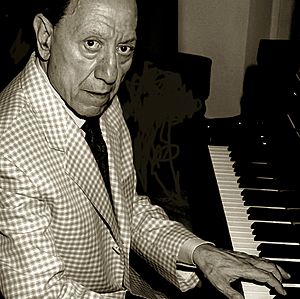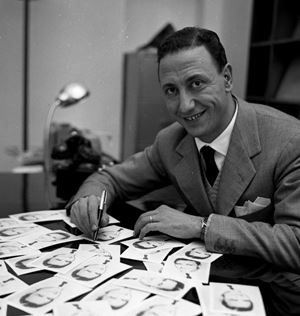Renato Carosone facts for kids
Quick facts for kids
Renato Carosone
|
|
|---|---|

Carosone in 1995
|
|
| Background information | |
| Birth name | Renato Carusone |
| Born | 3 January 1920 Naples, Kingdom of Italy |
| Died | 20 May 2001 (aged 81) Rome, Italy |
| Genres |
|
| Occupation(s) |
|
| Instruments | |
| Years active | 1935–2001 |
| Labels | |
Renato Carosone (born Renato Carusone; 3 January 1920 – 20 May 2001) was a famous Italian musician. He was a very important person in Italian music during the second half of the 20th century. He was also known for his modern take on canzone napoletana, a traditional music style from Naples.
Some of his biggest hits were "'O Sarracino", "Caravan Petrol", "Tu Vuò Fà L'Americano", "Maruzzella", and "Pigliate na' pastiglia". Carosone was one of the first Italian artists after World War II to sell many records and tour in the United States. He did this without singing in English, which was a big deal!
Contents
About Renato Carosone
Early Life and Music Beginnings
Renato Carosone was born in Naples, Italy, in 1920. He was the oldest of three children. His father worked at a theater and encouraged Renato to study music.
Renato studied piano and how to write music at the Naples Conservatory. He finished his studies in 1937 when he was only 17 years old. Soon after, he got a job as a band leader in Eritrea, a country in Africa.
He worked at the Odeon Club in Addis Ababa. There, he became a well-known musician. He mixed big-band music, Neapolitan songs, and African drum sounds.
In 1938, Carosone met a dancer named Lita Levidi in Addis Ababa. They fell in love and got married. Renato also adopted her son, Pino.
When World War II started, Carosone had to fight in Ethiopia. In 1946, after the war ended, he returned to Italy.
Because he had been away for so long and the war caused a break in his career, Carosone was not well-known in Italy. He started his music career again by playing piano for small dance bands. His new music was influenced by the rhythms and styles he learned in Eritrea. This new sound quickly got attention from music promoters.
Rising to Fame
In 1949, Carosone was asked to form a band for a club's opening night. He held auditions and chose Peter Van Wood, a guitarist from the Netherlands, and Gegè Di Giacomo, a drummer from Naples. Together, they formed the Trio Carosone. Later, they added Elek Bacsik, a musician from Hungary, who played bass, guitar, and violin. This made them a quartet.
During the 1950s, Carosone and his band became very popular. Many people wanted them to play concerts in Italy and other countries. Their record sales also went way up!
His song "Torero" became a hit in the United States in 1958. "Torero" was translated into twelve languages. About thirty different artists in the United States covered the song. Even famous groups like The Andrews Sisters sang it.
In 1957, Carosone and his band went on a tour of America. They started in Cuba and ended with a huge show at the famous Carnegie Hall in New York City.
After this success, Carosone signed with Capitol Records. They released his first two albums: Honeymoon in Rome (1957) and Renato Carosone! (1959). He then moved to Pathé and recorded Blue Italian Skies (1958). His fourth album, Carnevale Carosone (1960), was released by Parlophone.
Retirement and Comeback
At the peak of his career, Carosone announced he would retire from music in 1960. He felt that Rock and roll music was becoming too popular. He thought his swing and big-band sound might not be as liked anymore. He said he would "rather retire now on the crest of the wave" than worry about rock and roll taking over. His decision surprised many people.
Away from music, Carosone spent time on other hobbies, especially painting. In 2007, a museum in Rome called Castel Sant'Angelo held a big show of his paintings.
On August 9, 1975, Carosone made a comeback with a concert shown on TV. He then continued his music career. He performed live concerts, appeared at the Sanremo Music Festival, and was on TV until the late 1990s.
Famous Songs
Many of Carosone's songs were created with Nicola Salerno, a lyricist who used the name Nisa. Some of their greatest hits include "'O suspiro", "Torero", "Tu vuò fà l'americano", "Mambo Italiano", "Caravan Petrol", "Pigliate 'na pastiglia", and "'O Sarracino".
Some other famous songs not written with Nisa were "...E la barca tornò sola" (a funny version of another song), "Tre numeri al lotto", "Maruzzella" (which he wrote for his wife), and "'O russo e 'a rossa'".
Death
Renato Carosone passed away on May 20, 2001, in Rome, Italy. He was 81 years old.
Discography
- Honeymoon in Rome (1958)
- Blue Italian Skies (1958)
- Renato Carosone (1959)
- Carnevale Carosone (1960)
- Pianofortissimamente Carosone (1975)
- Sempre (1982)
- Nu' canzoncella doce doce (1982)
See also
 In Spanish: Renato Carosone para niños
In Spanish: Renato Carosone para niños
- Tu Vuò Fà L'Americano
- We No Speak Americano


